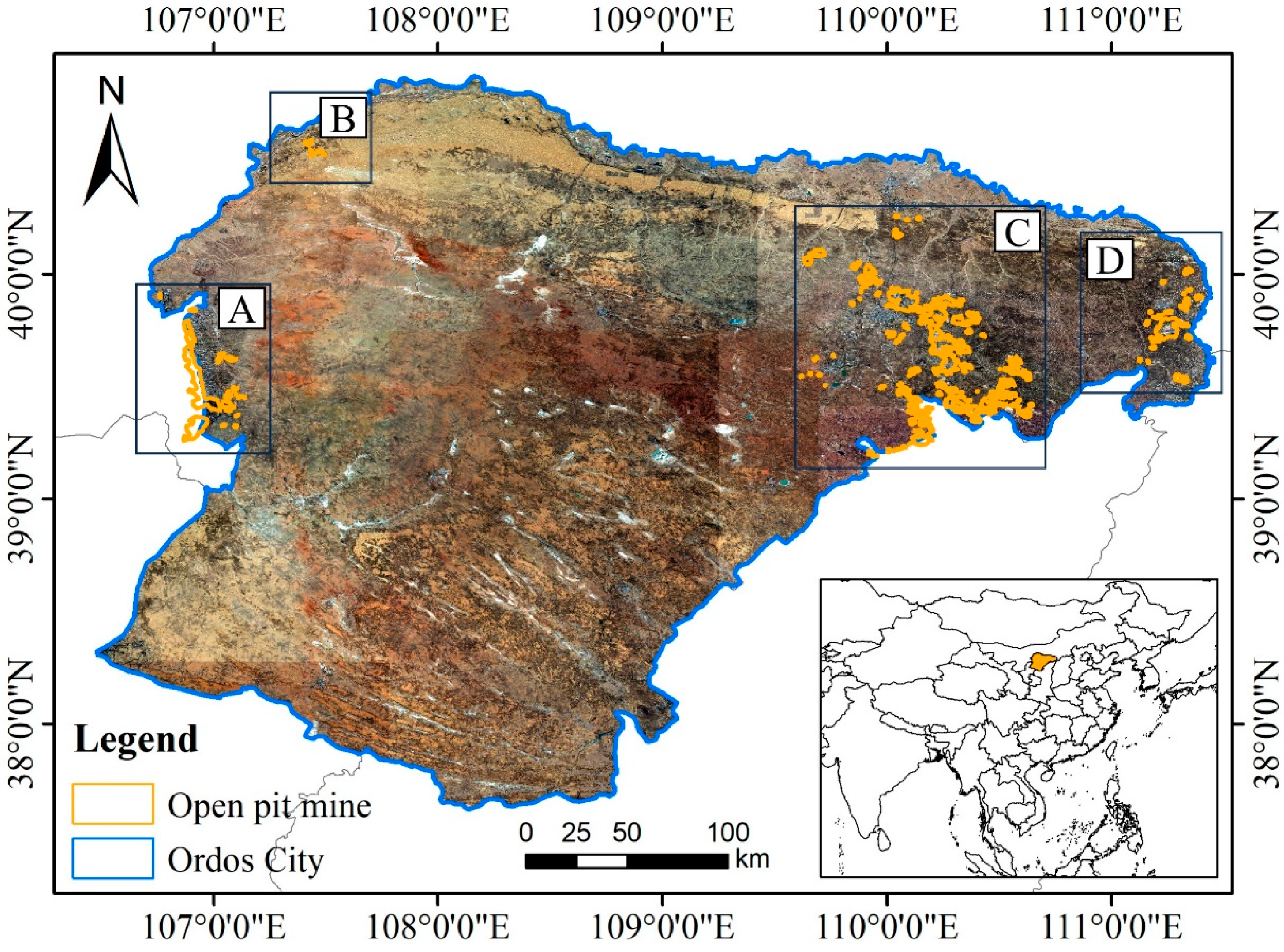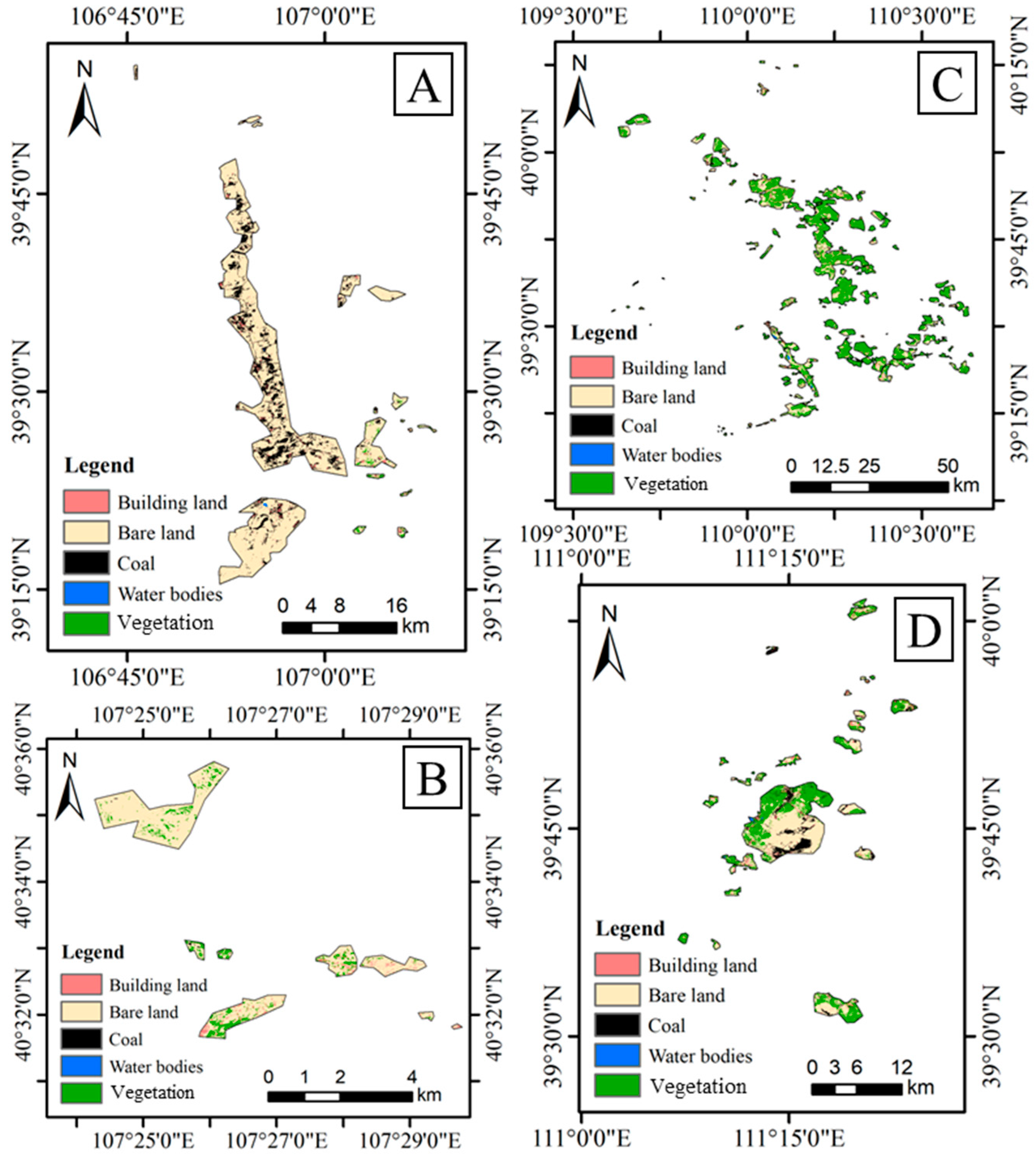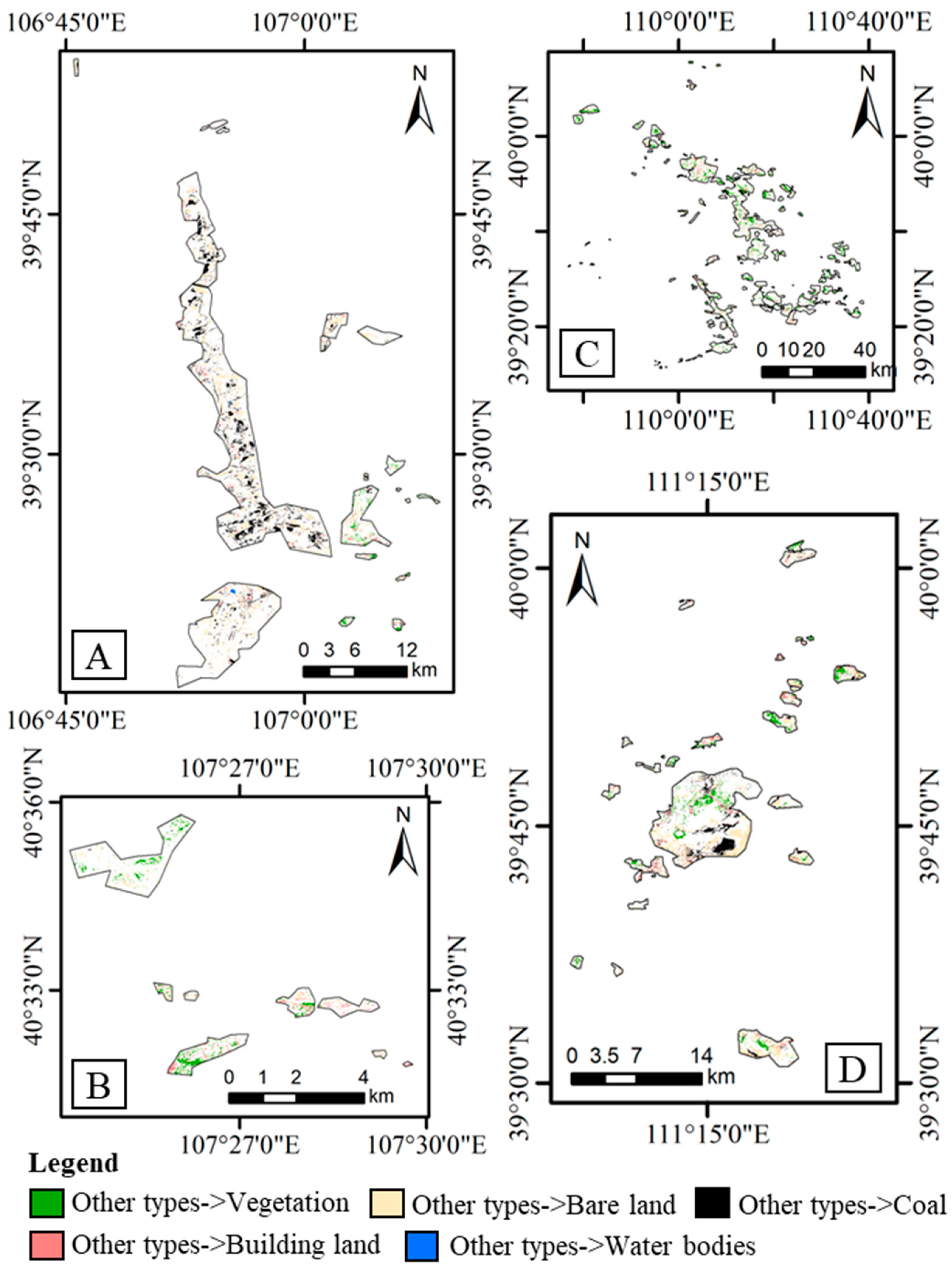Exploring Land-Cover Types and Their Changes in the Open-Pit Mining Area of Ordos City Using Sentinel-2 Imagery
Abstract
:1. Introduction
2. Materials and Methods
2.1. Study Area
2.2. Data
2.3. Methods
2.3.1. Acquisition of Temporal–Spectral Features in Remote Sensing Images
2.3.2. Determination of Land-Cover Types Based on Random Forest
2.3.3. Calculation of Changes in Land-Cover Types
3. Results
3.1. Land-Cover Types for Open-Pit Mining Areas in Ordos City, 2019
3.2. Land-Cover Types for Open-Pit Mining Areas in Ordos City, 2022
3.3. Changes in the Land Cover of Open-Pit Mining Areas in Ordos City, 2019–2022
4. Discussion
4.1. Evaluation of Land-Cover Type Accuracy
4.2. Recommendations for the Governance of Mining Areas in Ordos City
4.3. Limitations and Future Work
5. Conclusions
Author Contributions
Funding
Institutional Review Board Statement
Informed Consent Statement
Data Availability Statement
Acknowledgments
Conflicts of Interest
References
- Haidai, O.; Ruskykh, V.; Ulanova, N.; Prykhodko, V.; Cabana, E.C.; Dychkovskyi, R.; Howaniec, N.; Smolinski, A. Mine Field Preparation and Coal Mining in Western Donbas: Energy Security of Ukraine—A Case Study. Energies 2022, 15, 4653. [Google Scholar] [CrossRef]
- Hamilton, C.; Song, J.; Cui, R.; Olson, C.; Cui, D. Evaluating provincial-level employment challenge during the coal transition in China. Adv. Clim. Chang. Res. 2022, 13, 729–737. [Google Scholar] [CrossRef]
- Hower, J.C.; Finkelman, R.B.; Eble, C.F.; Arnold, B.J. Understanding coal quality and the critical importance of comprehensive coal analyses. Int. J. Coal Geol. 2022, 263, 104120. [Google Scholar] [CrossRef]
- Ponnudurai, V.; Senthil Kumar, P.; Sankar Muthuvelu, K.; Velmurugan, S.; Subhani, S.; Arumugam, L.; Rajarathinam, R. Investigation on future perspectives of ex-situ biogenic methane generation from solid waste coal and coal washery rejects. Fuel 2022, 318, 123497. [Google Scholar] [CrossRef]
- Kacker, K.; Lange, I. Inter-regional coal mine competition in the US: Evidence from rail restrictions. Energy Econ. 2022, 110, 105998. [Google Scholar] [CrossRef]
- Zhu, L.; Xing, H.; Hou, D. Analysis of carbon emissions from land cover change during 2000 to 2020 in Shandong Province, China. Sci. Rep. 2022, 12, 8021. [Google Scholar] [CrossRef]
- Zhu, L.; Shi, M.; Fan, D.; Tu, K.; Sun, W. Analysis of Changes in Vegetation Carbon Storage and Net Primary Productivity as Influenced by Land-Cover Change in Inner Mongolia, China. Sustainability 2023, 15, 4735. [Google Scholar] [CrossRef]
- Zhu, L.; Sun, W.; Wu, J.; Fan, D. Spatiotemporal Distribution of Carbon Sink Indicators—NPP and Its Driving Analysis in Ordos City, China. Appl. Sci. 2023, 13, 6457. [Google Scholar] [CrossRef]
- Dewan, A.; Kabir, M.H.; Nahar, K.; Rahman, Z. Urbanisation and environmental degradation in Dhaka Metropolitan Area of Bangladesh. Int. J. Environ. Sustain. Dev. 2012, 11, 118–147. [Google Scholar] [CrossRef]
- Zhong, C.; Guo, H.; Swan, I.; Gao, P.; Yao, Q.; Li, H. Evaluating trends, profits, and risks of global cities in recent urban expansion for advancing sustainable development. Habitat Int. 2023, 138, 102869. [Google Scholar] [CrossRef]
- Xia, B.; Kong, F.; Zhou, J.; Wu, X.; Xie, Q. Land Resource Use Classification Using Deep Learning in Ecological Remote Sensing Images. Comput. Intell. Neurosci. 2022, 2022, 7179477. [Google Scholar] [CrossRef] [PubMed]
- Guan, R.; Li, Z.; Li, T.; Li, X.; Yang, J.; Chen, W. Classification of Heterogeneous Mining Areas Based on ResCapsNet and Gaofen-5 Imagery. Remote Sens. 2022, 14, 3216. [Google Scholar] [CrossRef]
- Liu, Y.; Zhang, J. A lightweight convolutional neural network based on dense connection for open-pit coal mine service identification using the edge-cloud architecture. J. Cloud Comput. 2023, 12, 32. [Google Scholar] [CrossRef]
- Hai, W.; Xia, N.; Song, J.; Tang, M. Identification and Monitoring of Surface Elements in Open-Pit Coal Mine Area Based on Multi-Source Remote Sensing Images. Pol. J. Environ. Stud. 2022, 31, 4127–4136. [Google Scholar] [CrossRef]
- Tang, H.; Fang, J.; Xie, R.; Ji, X.; Li, D.; Yuan, J. Impact of Land Cover Change on a Typical Mining Region and Its Ecological Environment Quality Evaluation Using Remote Sensing Based Ecological Index (RSEI). Sustainability 2022, 14, 12694. [Google Scholar] [CrossRef]
- Hong, F.; He, G.; Wang, G.; Zhang, Z.; Peng, Y. Monitoring of Land Cover and Vegetation Changes in Juhugeng Coal Mining Area Based on Multi-Source Remote Sensing Data. Remote Sens. 2023, 15, 3439. [Google Scholar] [CrossRef]
- Su, X.; Qian, Z. Neoliberal planning, master plan adjustment and overbuilding in China: The case of Ordos City. Cities 2020, 105, 102748. [Google Scholar] [CrossRef]
- Zhang, H.; Guo, J.; Li, X.; Liu, Y.; Wang, T. Spatiotemporal Variation in and Responses of the NDVI to Climate in Western Ordos and Eastern Alxa. Sustainability 2023, 15, 4375. [Google Scholar] [CrossRef]
- Pan, W.; Li, Y.; Zhang, C.; Shi, X.; Cui, H.; Wang, B.; Li, Y.; Wang, Y. Coal Burst Prevention Technology and Engineering Practice in Ordos Deep Mining Area of China. Sustainability 2023, 15, 159. [Google Scholar] [CrossRef]
- Ao, Z.; Wang, Z.; Zhou, W.; Qiao, Y.; Wahab, A.; Yang, Z.; Nie, S.; Liu, Z.; Zhu, L. CFD Simulation Based Ventilation and Dust Reduction Strategy for Large Scale Enclosed Spaces in Open Pit Coal Mines—A Case of Coal Shed. Sustainability 2023, 15, 11651. [Google Scholar] [CrossRef]
- Zhang, B.; Zhang, R.; Han, P.-F.; Wang, J.; Wan, L. Evolution of Hydrogeochemistry in the Haolebaojinao Watershed of the Ordos Basin, China. Sustainability 2023, 15, 5091. [Google Scholar] [CrossRef]
- Li, J. Responses of Vegetation NDVI to Climate Change and Land. Appl. Sci. 2022, 12, 7288. [Google Scholar] [CrossRef]
- Wang, Z.; Hasi, E. Research on the Development of Deserticulture and Desertification Land Use Benefits Evaluation in Ordos City. Land 2023, 12, 1254. [Google Scholar] [CrossRef]
- Su, X.; Qian, Z. Neoliberal financial governance and its transformation under real estate boom and bust: The case of Ordos City, China. Land Use Policy 2022, 112, 104728. [Google Scholar] [CrossRef]
- Li, J.; Ma, Z.; Sun, H.; Chen, W. Driving factor analysis and dynamic forecast of industrial carbon emissions in resource-dependent cities: A case study of Ordos, China. Environ. Sci. Pollut. Res. 2023, 30, 92146–92161. [Google Scholar] [CrossRef]
- Fang, Z.; Ding, T.; Chen, J.; Xue, S.; Zhou, Q.; Wang, Y.; Wang, Y.; Huang, Z.; Yang, S. Impacts of land use/land cover changes on ecosystem services in ecologically fragile regions. Sci. Total Environ. 2022, 831, 154967. [Google Scholar] [CrossRef]
- Rashid, M.; Isah, U.; Athar, M.; Benhelal, E. Energy and Chemicals Production from Coal-based Technologies: A Review. ChemBioEng Rev. 2023. early view. [Google Scholar] [CrossRef]
- Shah, A.A.; Usto, A.; Ahmed, T.; Jatoi, A.; Hashmi, Z.; Chandio, Z.; Ahmed, S.; Iqbal, A.; Siyal, S.; Shah, A. Facile application of used engine oil in high sulfur coal briquetting to reduce the hazardous emission gases. Int. J. Coal Prep. Util. 2022, 43, 1139–1151. [Google Scholar] [CrossRef]
- Iglauer, S.; Akhondzadeh, H.; Abid, H.; Paluszny, A.; Keshavarz, A.; Ali, M.; Giwelli, A.; Esteban, L.; Sarout, J.; Lebedev, M. Hydrogen Flooding of a Coal Core: Effect on Coal Swelling. Geophys. Res. Lett. 2022, 49, e2021GL096873. [Google Scholar] [CrossRef]
- Ren, J.; Ashida, R.; Kawase, M.; Sakai, K.; Okuyama, N. Development of a Novel Mild Depolymerization Method of Coal by Combining Oxygen Oxidation and Formic Acid Reduction Reactions. ACS Omega 2023, 8, 2531–2537. [Google Scholar] [CrossRef]
- Labzovskii, L.D.; Belikov, D.A.; Damiani, A. Spaceborne NO2 observations are sensitive to coal mining and processing in the largest coal basin of Russia. Sci. Rep. 2022, 12, 12597. [Google Scholar] [CrossRef] [PubMed]
- Martus, E.; Fortescue, S. Russian coal in a changing climate: Risks and opportunities for industry and government. Clim. Chang. 2022, 173, 26. [Google Scholar] [CrossRef]
- Gosens, J.; Turnbull, A.B.H.; Jotzo, F. China’s decarbonization and energy security plans will reduce seaborne coal imports: Results from an installation-level model. Joule 2022, 6, 782–815. [Google Scholar] [CrossRef]
- Mukherjee, T.; Gupta, A.; Deodhar, A.; Runkana, V. Real-time coal classification in thermal power plants. Control Eng. Pract. 2023, 130, 105377. [Google Scholar] [CrossRef]
- Roy, P.; Hossain, M.N.; Uddin, S.M.M.; Hossain, M.M. Unraveling the sustainability aspects of coal extraction and use in Bangladesh using material flow analysis and life cycle assessment. J. Clean. Prod. 2023, 387, 135895. [Google Scholar] [CrossRef]
- Sinha, S.K.; Srikanth, R.; Mahalingam, S. Regulatory framework for India’s energy security and sustainability. Energy Policy 2022, 162, 112815. [Google Scholar] [CrossRef]
- Santiago, V.; Guerrero Zabala, F.; Sanchez-Barra, A.J.; Deisman, N.; Chalaturnyk, R.J.; Zhong, R.; Hurter, S. Experimental investigation of the flow properties of layered coal-rock analogues. Chem. Eng. Res. Des. 2022, 186, 685–700. [Google Scholar] [CrossRef]
- Maus, V.; Giljum, S.; Gutschlhofer, J.; da Silva, D.M.; Probst, M.; Gass, S.L.B.; Luckeneder, S.; Lieber, M.; McCallum, I. Global-scale mining polygons (Version 1). PANGAEA 2020. [Google Scholar] [CrossRef]
- Zhu, L.; Xing, H.; Zhao, L.; Qu, H.; Sun, W. A change type determination method based on knowledge of spectral changes in land cover types. Earth Sci. Inform. 2023, 16, 1265–1279. [Google Scholar] [CrossRef]
- Jin, S.; Liu, Y.; Fagherazzi, S.; Mi, H.; Qiao, G.; Xu, W.; Sun, C.; Liu, Y.; Zhao, B.; Fichot, C.G. River body extraction from sentinel-2A/B MSI images based on an adaptive multi-scale region growth method. Remote Sens. Environ. 2021, 255, 112297. [Google Scholar] [CrossRef]
- Data, S. Analysis of the Spatial and Temporal Pattern of Changes in Abandoned Farmland Based on Long Time Series of Remote Sensing Data. Remote Sens. 2021, 13, 2549–2568. [Google Scholar]
- Zhu, L.; Jiang, X.; Zhao, L.; Qu, H.; Sun, W. A temporal-spectral value and shape change detection method integrating thematic index information and spectral band information. Environ. Sci. Pollut. Res. 2023, 30, 47408–47421. [Google Scholar] [CrossRef] [PubMed]
- Khabbazan, S.; Steele-Dunne, S.C.; Vermunt, P.; Judge, J.; Vreugdenhil, M.; Gao, G. The influence of surface canopy water on the relationship between L-band backscatter and biophysical variables in agricultural monitoring. Remote Sens. Environ. 2022, 268, 112789. [Google Scholar] [CrossRef]
- Zhu, L.; Guo, Z.; Xing, H.; Sun, W. A coupled temporal-spectral-spatial multidimensional information change detection framework method: A case of the 1990–2020 Tianjin, China. IEEE J. Sel. Top. Appl. Earth Obs. Remote Sens. 2023, 16, 5741–5758. [Google Scholar] [CrossRef]
- Mugiraneza, T.; Hafner, S.; Haas, J.; Ban, Y. Monitoring urbanization and environmental impact in Kigali, Rwanda using Sentinel-2 MSI data and ecosystem service bundles. Int. J. Appl. Earth Obs. Geoinf. 2022, 109, 102775. [Google Scholar] [CrossRef]
- Ghazali, E.; Johari, M.A.M.; Fauzi, M.A.; Nor, N.M. An Overview of Characterisation, Utilisation, and Leachate Analysis of Clinical Waste Incineration Ash. Int. J. Environ. Res. 2022, 16, 69. [Google Scholar] [CrossRef]
- Yang, B.; Qin, L.; Liu, J.; Liu, X. UTRNet: An Unsupervised Time-Distance-Guided Convolutional Recurrent Network for Change Detection in Irregularly Collected Images. IEEE Trans. Geosci. Remote Sens. 2022, 60, 4410516. [Google Scholar] [CrossRef]
- Zhu, S.; Song, Y.; Zhang, Y.; Zhang, Y. ECFNet: A Siamese Network With Fewer FPs and Fewer FNs for Change Detection of Remote-Sensing Images. IEEE Geosci. Remote Sens. Lett. 2023, 20, 6001005. [Google Scholar] [CrossRef]
- Nguyen, L.H.; Joshi, D.R.; Clay, D.E.; Henebry, G.M. Characterizing land cover/land use from multiple years of Landsat and MODIS time series: A novel approach using land surface phenology modeling and random forest classifier. Remote Sens. Environ. 2020, 238, 111017. [Google Scholar] [CrossRef]
- Yanguas-Parra, P.A.; Malz, N.; Oei, P.-Y.; Furnaro, A.; Hauenstein, C.; Quiceno, G.; Corral-Montoya, F.; Mitterecker, T.; Hanto, J. Perspective: How a short-term relapse to coal could put exporting countries and just transition processes at risk. Energy Res. Soc. Sci. 2023, 97, 102989. [Google Scholar] [CrossRef]
- Arnold, B.J. A review of element partitioning in coal preparation. Int. J. Coal Geol. 2023, 274, 104296. [Google Scholar] [CrossRef]
- Patria, A.A.; Anggara, F. Petrological, mineralogical, and geochemical compositions of coal in the Ombilin Basin, West Sumatra, Indonesia. Int. J. Coal Geol. 2022, 262, 104099. [Google Scholar] [CrossRef]
- Cakmak, E.; Hower, J.C.; Mathews, J.P.; Weisenberger, M.C.; Kaplan, R.; Lacy, J.; Zhang, Y.; Lara-Curzio, E. Microstructural diversity and digestion yields of select bituminous and subbituminous coals as raw material candidates for carbon fiber precursor production. Fuel 2023, 348, 128545. [Google Scholar] [CrossRef]
- Delina, L.L. Coal development and its discontents: Modes, strategies, and tactics of a localized, yet networked, anti-coal mobilisation in central Philippines. Extr. Ind. Soc. 2022, 9, 101043. [Google Scholar] [CrossRef]
- Azam, S.; Liu, S.; Bhattacharyya, S.; Liu, A. Measurement and modeling of water vapor sorption on nano-sized coal particulates and its implication on its transport and deposition in the environment. Sci. Total Environ. 2023, 889, 164095. [Google Scholar] [CrossRef]
- Michieka, N.M.; Graziano, M.; Musso, M.; Fouquet, R. Energy transitions and labor market patterns in the U.S. coal industry. Struct. Chang. Econ. Dyn. 2022, 63, 501–514. [Google Scholar] [CrossRef]
- Manzoni, M.; Monti-Guarnieri, A.; Molinari, M.E. Joint exploitation of spaceborne SAR images and GIS techniques for urban coherent change detection. Remote Sens. Environ. 2021, 253, 112152. [Google Scholar] [CrossRef]
- Saha, S.; Member, S.; Solano-correa, Y.T.; Bovolo, F.; Member, S.; Bruzzone, L. Unsupervised Deep Transfer Learning-Based Change Detection for HR Multispectral Images. IEEE Geosci. Remote Sens. Lett. 2020, 99, 856–860. [Google Scholar] [CrossRef]
- Slingsby, J.A.; Moncrieff, G.R.; Wilson, A.M. Near-real time forecasting and change detection for an open ecosystem with complex natural dynamics. ISPRS J. Photogramm. Remote Sens. 2020, 166, 15–25. [Google Scholar] [CrossRef]
- Ballère, M.; Bouvet, A.; Mermoz, S.; Le Toan, T.; Koleck, T.; Bedeau, C.; André, M.; Forestier, E.; Frison, P.L.; Lardeux, C. SAR data for tropical forest disturbance alerts in French Guiana: Benefit over optical imagery. Remote Sens. Environ. 2021, 252, 112159. [Google Scholar] [CrossRef]






| Land-Cover Types | Building Land | Bare Land | Coal | Water Bodies | Vegetation |
|---|---|---|---|---|---|
| Area/km2 | 9.82 | 576.59 | 100.93 | 4.37 | 631.80 |
| Proportion/% | 0.74 | 43.57 | 7.63 | 0.33 | 47.74 |
| Land-Cover Types | Building Land | Bare Land | Coal | Water Bodies | Vegetation |
|---|---|---|---|---|---|
| Area/km2 | 59.24 | 519.91 | 88.35 | 3.34 | 652.67 |
| Proportion/% | 4.48 | 39.28 | 6.68 | 0.25 | 49.31 |
| Land-Cover Types | Building Land | Bare Land | Coal | Water Bodies | Vegetation |
|---|---|---|---|---|---|
| Amount of change/km2 | 49.42 | −56.68 | −12.58 | −1.03 | 20.87 |
| Rate of change/% | 503.14 | −9.83 | −12.46 | −23.50 | 3.30 |
| Area/km2 | Building Land | Bare Land | Coal | Water Bodies | Vegetation | Total 2022 |
|---|---|---|---|---|---|---|
| Building land | 6.73 | 25.82 | 6.73 | 0.16 | 19.79 | 59.24 |
| Bare land | 1.54 | 393.93 | 46.45 | 0.90 | 77.10 | 519.91 |
| Coal | 0.08 | 35.32 | 40.32 | 0.53 | 12.10 | 88.35 |
| Water bodies | 0.00 | 0.29 | 0.37 | 2.66 | 0.02 | 3.34 |
| Vegetation | 1.48 | 121.24 | 7.05 | 0.12 | 522.78 | 652.67 |
| Total 2019 | 9.82 | 576.59 | 100.93 | 4.37 | 631.80 | 1323.52 |
| Year | Overall accuracy/% | Kappa | ||||
| 2019 | 94.32 | 0.91 | ||||
Disclaimer/Publisher’s Note: The statements, opinions and data contained in all publications are solely those of the individual author(s) and contributor(s) and not of MDPI and/or the editor(s). MDPI and/or the editor(s) disclaim responsibility for any injury to people or property resulting from any ideas, methods, instructions or products referred to in the content. |
© 2023 by the authors. Licensee MDPI, Basel, Switzerland. This article is an open access article distributed under the terms and conditions of the Creative Commons Attribution (CC BY) license (https://creativecommons.org/licenses/by/4.0/).
Share and Cite
Zhu, L.; Zhang, Y.; Chen, K.; Liu, Q.; Sun, W. Exploring Land-Cover Types and Their Changes in the Open-Pit Mining Area of Ordos City Using Sentinel-2 Imagery. Sustainability 2023, 15, 14053. https://doi.org/10.3390/su151914053
Zhu L, Zhang Y, Chen K, Liu Q, Sun W. Exploring Land-Cover Types and Their Changes in the Open-Pit Mining Area of Ordos City Using Sentinel-2 Imagery. Sustainability. 2023; 15(19):14053. https://doi.org/10.3390/su151914053
Chicago/Turabian StyleZhu, Linye, Yonggui Zhang, Kewen Chen, Qiang Liu, and Wenbin Sun. 2023. "Exploring Land-Cover Types and Their Changes in the Open-Pit Mining Area of Ordos City Using Sentinel-2 Imagery" Sustainability 15, no. 19: 14053. https://doi.org/10.3390/su151914053




